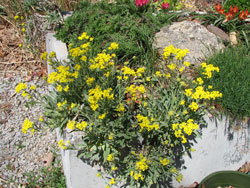Resource Library
Plant of the Week: Gold Alyssum, Basket of
The University of Arkansas System Division of Agriculture does not promote, support or recommend plants featured in "Plant of the Week." Please consult your local Extension office for plants suitable for your region.
Plant of the Week
Basket of Gold Alyssum
Latin: Aurinia saxatilis

Spring presents an avalanche of colors as bulbs and early blooming perennials rush headlong into the season. Many of these early bloomers are small and easily overpowered by larger, more thuggish plants, so the rock garden is a perfect place to grow them. One of the brightest of these early-season plants is the yellow flowered Basket of Gold Alyssum (Aurinia saxatilis).
Basket of Gold Alyssum, sometimes incorrectly listed as Alyssum saxatilis, is a member of the crucifer family and is occasionally called goldentuft or madwort. It grows as a sprawling evergreen perennial with stems that become somewhat woody at the base. Basal leaves are oblong and three-to-four inches long and usually gray or gray-green in color with a short pubescence. Leaves attached to the flowering stem are smaller.
In mid-spring, flowering stems begin elongating and produce terminal clusters of bright yellow flowers. The multi-branched, flowering panicles are two to three inches across and composed of a multitude of tiny, yellow, four-petaled blossoms. Following flowering, the small, wafer-like seedpods are produced in abundance. Before flowering, the clump of ever-gray leaves may be four to six inches tall; in flower plants, they are 12 to 16 inches tall.
The name "alyssum" is an old one first used by Dioscorides, the early Greek physician and botanist, during the first century of the Christian era. When the writings of the Greeks and Romans were resurrected during the Renaissance, European authors were never quite sure which plant was being described.
The name "madwort" comes from this early treatise on the use of this plant to cure the bite of a mad dog. According to Gerard, in the 16th century this was one powerful plant, because all you had to do was present it to the patient and the rabies were cured. Don’t try this remedy at home!
The true alyssums, all of which I have grown, have yellow flowers and are similar to basket of gold, except they tend to be much smaller plants with a prostrate or trailing habit and smaller flowers. The sweet alyssum of the bedding plant trade was at one time classified as an alyssum, but is now called Lobularia maritima.
Basket of gold alyssum is native to southern Europe and Turkey, where it grows on rocky cliffs of the Mediterranean region and in the mountains. In botany, a saxatile plant is one that grows amongst the rocks. It was first introduced to England from Crete in 1710 and first showed up on seed lists in this country in 1796.
Basket of gold is hardy to zone 3 north and, at least in theory, to zone 10. But, as an alpine plant from an arid region, it tends to be short-lived in the hot and humid states of the southeast.
It is grown to perfection in areas with a maritime climate or in mountainous regions. This plant requires good drainage and five to six hours of sun to do its best. Though cultivars are listed, only ‘Compacta’ is common. It is easily grown from seed, with flowering delayed until the second season. Shearing after flowering keeps the plants compact and prevents seed from forming, which has led to escapes in parts of the Pacific Northwest and New England.
By: Gerald Klingaman, retired
Extension Horticulturist - Ornamentals
Extension News - April 9, 2010
The University of Arkansas System Division of Agriculture does not maintain lists of retail outlets where these plants can be purchased. Please check your local nursery or other retail outlets to ask about the availability of these plants for your growing area